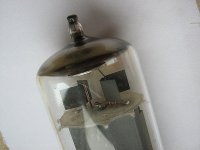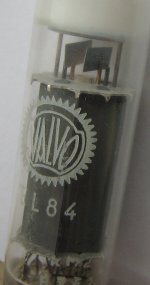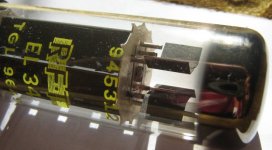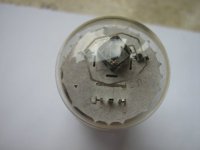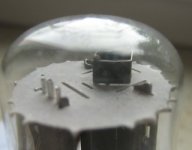Nice, thanks Nigel. What I don't understand is those plates to 'cool the heat from the grid', at around 4 min into the movie. Do they mean coling the anode?
The job of designing those assembly machines seems like a more interesting and creative job than assembling valves though!
Jan
The job of designing those assembly machines seems like a more interesting and creative job than assembling valves though!
Jan
Last edited:
Great movie, thank you @nigelwright7557. One won't be able to show how you make a transistors in such details in a real factory.
Some younger kids may think it's a science fiction movie 🙂
Some younger kids may think it's a science fiction movie 🙂
I also see a lot of extremely boring jobs, you probably wouldn't be able to get staff for that these days.
Or if you could, tubes would be $1k each.
Jan
Or if you could, tubes would be $1k each.
Jan
No, these are cooling fins, welded directly to the grid support rods.I don't understand is those plates to 'cool the heat from the grid', at around 4 min into the movie. Do they mean coling the anode?
Some tubes have them, some don't.
Most have them on Grid 1, some on Grid 2.
e.g. (random pick)
mainly power pentodes:
Siemens PL519 - fins on G1
Telefunken PL508 - fins on G1
Valvo PL508 - no fins
Valvo EL84 - fins on G1
Valvo PCL85 - fins on G2
rare, but also on some triodes:
Telefunken E92CC - fins on G
Valvo E90CC - no fins
Attachments
Interesting - never realised there's a benefit in cooling grid 1.
Would it make a difference in the characreristics, or reliability?
Jan
Would it make a difference in the characreristics, or reliability?
Jan
Grid current. The grid is close to a red-hot furnace. Cooling the grid reduces its ability to emit electrons.
But the grid current is already extremely low (for the usual audio tubes).
Is it really effective?
Jan
Is it really effective?
Jan
I would question it on an EL84. But the PL509/519 tubes are not audio tubes, they work more like switches when used for the intended purpose. Edit: I seem to remember g1 in sweep tubes is very close to the cathode, maybe that's the reason it get's hot?
Last edited:
Only because of the cooling plates. If they weren't there, the grid would be hotter and emission is dependent on temperature.But the grid current is already extremely low (for the usual audio tubes).
Is it really effective?
Jan
Indeed. People think valves are low technology, but look at the degree of sophistication required for their manufacture. And note how much was unstated by the frightfully posh voice-over commentator.
EL84, EL34 pics below.I would question it on an EL84. But the PL509/519 tubes are not audio tubes, they work more like switches when used for the intended purpose. Edit: I seem to remember g1 in sweep tubes is very close to the cathode, maybe that's the reason it get's hot?
AB2 operation ? guitar amps ?
Attachments
The thing that interests me, not described in that interesting film, is how they switched tube types and heater voltages. With so many dependent steps it must have been a nightmare switching from one tube to another.
In the early sixties I was a student apprentice at the Mullard New Road Mitchum Junction factory which had become a kind of skunk works rather than manufacturing.
I was rotated through the various projects in development there like colour crt's , image intensifiers for the Army, an early integrated circuit device for the Blue Streak IRBM.
Looking back it was very good and interesting education. Finally I ended up in the Ferrites department making a ferrite core memory module for a Royal Navy
computer called ADA. That got me into computing when I graduated and left.
The film brought back memories of the atmosphere in the company then, though the New Road factory was getting a bit run down compared to the Blackburn plant.
I was rotated through the various projects in development there like colour crt's , image intensifiers for the Army, an early integrated circuit device for the Blue Streak IRBM.
Looking back it was very good and interesting education. Finally I ended up in the Ferrites department making a ferrite core memory module for a Royal Navy
computer called ADA. That got me into computing when I graduated and left.
The film brought back memories of the atmosphere in the company then, though the New Road factory was getting a bit run down compared to the Blackburn plant.
'frightfully posh' - as far as I remember, you guys ALL talked like that at the time 😎Indeed. People think valves are low technology, but look at the degree of sophistication required for their manufacture. And note how much was unstated by the frightfully posh voice-over commentator.
Jan
Gor blimey no, guv. Only those selected for public speaking. And at that point, I'll stop because I remember that I was the one who said, "No political posts on diyAudio".
There is a YouTube film about early Ford V8 engines that is similar. They make the tolerances and engineering sound impressive, but of course the reality is that by today's standards they were just damn crude. Those mica washers were a serious health hazard. A lot of pride was invested in things that don't matter anymore. There was a TV manufacturer that proudly advertised that their TV were hand wired! Early color TVs used tubes and therefore had a limited number of active circuits, one of the reasons the picture quality was terrible. There is a perversion where people take pride in the amount of other people's time they own or waste.
I find the film depressing because I remember vacuum tubes, the bulk, the heat, the stink, the filth, the hazards, and perishable performance. Most people had AC/DC AM radios that were wired directly to one side of the AC line and the plastic cases turned brown and cracked. 20% was standard precision for carbon composition resistors that drifted quickly, especially if they ran hot. I corrected the bias in a tube phase splitter and moved the clipping power from 60W to about 100W. A couple times, I was bitten by a 6L6 plate voltage. Selenium rectifiers and germanium transistors, transformer coupled audio, TTL and MSI logic. Remember "JK flip-flops"? Good riddance to all those nasty old technologies.
I find the film depressing because I remember vacuum tubes, the bulk, the heat, the stink, the filth, the hazards, and perishable performance. Most people had AC/DC AM radios that were wired directly to one side of the AC line and the plastic cases turned brown and cracked. 20% was standard precision for carbon composition resistors that drifted quickly, especially if they ran hot. I corrected the bias in a tube phase splitter and moved the clipping power from 60W to about 100W. A couple times, I was bitten by a 6L6 plate voltage. Selenium rectifiers and germanium transistors, transformer coupled audio, TTL and MSI logic. Remember "JK flip-flops"? Good riddance to all those nasty old technologies.
- Home
- Amplifiers
- Tubes / Valves
- Interesting Mullard film
